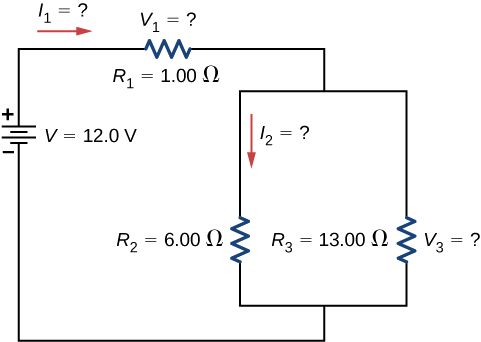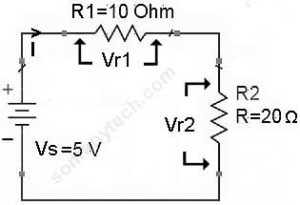Calculating voltage drop across a resistor in parallel
In a parallel circuit there is more than one loop or. In the image above you will see two circuits.

Calculating Voltage Drop Across Resistors Youtube
1 pH 0000000000001 10¹² H.

. V AB Then the Thevenins Equivalent circuit is shown below with the 40Ω resistor connected. The equation for calculating total resistance in a parallel circuit for any number of parallel resistances is sometimes written like this. The potential difference across each resistor is same as the resistors are connected in parallel and the voltage across these resistors are the same.
A meter can be calibrated as a DC voltmeter if the resistance of the coil is known by calculating the voltage required to generate a full-scale current. Inductance characterizes the ability of an electrical conductor to convert changes in electric current into changes in electrical potential in both this conductor self-inductance and in any nearby conductors mutual inductance. As the first switch SW1 is closed the voltage across resistor R1 will increase to full battery voltage while the.
The distinction between series and parallel circuits is highlighted by calculating the total resistance from several resistors. Beginalign V V_1 V_2 V_3 V_3 V - V_1 - V_2 18 - 2 - 6 V_3 text10text V endalign. R 5 ohm.
The first circuit with only one resistor and the second circuit with two resistors. As we know a resistor is a passive electrical element that provides electrical resistance to the flow of current. In this case the current through each resistor is the same so V determines the brightness.
Ω is the SI unit of electrical resistance named after. Knowing the voltage drop across the parallel-connected resistors R 1 and R 4 allows one to use the Ohms law equation ΔV I R to determine the current in the two branches. The lower the resistance the more power will be used when the button is hit.
This voltage divider equation can be used for any number of series resistances connected together because of the proportional relationship between each resistance R and its corresponding voltage drop VNote however that this equation is given. Understanding Voltage Drop Across a Resistor. When talking about the voltage drop across a resistor we are referring to the voltage across a resistor or the voltage once the current flow has gone through a resistor.
Since the voltage drop across the 30 resistor is greatest it would be the brightest bulb. The total resistance of. V Rx is the voltage drop across the resistor R X is the value of the resistor and R T is the total resistance of the series network.
Conversely since the voltage drop across the 10 resistor is least it would be the dimmest bulb. The voltage across this resistor is negative since were moving from the high potential side to the low potential side and is represented by -20I. 1 nH 0000000001 10⁹ H.
In a parallel connection of resistors the voltage across each resistor is the same. Find the current flowing through the other two resistors. We start by calculating the total resistance of Parallel Circuit 1.
In the circuit diagram given below the current flowing across 5 ohm resistor is 1 amp. The voltage drop is also known as IR drop. If you know the voltage across the whole circuit the answer is surprisingly easy.
The voltage drop across a resistor is nothing but simply a value of voltage across the resistor. In this configuration the voltage drop across each resistor is the same. Given I 1 amp.
Ohms law states that the voltage across a resistor is proportional to the current passing through it where the constant of proportionality is the resistance For example if a 300-ohm resistor is attached across the terminals of a 12-volt battery then a current of 12 300 004 amperes flows through that resistorThe ohm symbol. Using Ohms law calculate the voltage drop across each resistor. For condition 1 you dont want the resistors value too low.
When a 15 Volt battery is connected in parallel with a 6-ohm and 2-ohm resistor the current flowing through the 6-ohm resistor is equal to the voltage across the 6-ohm resistorthat is 15 Volts divided by the resistors value of 6 ohms. Lets say a circuit with two parallel resistors is powered by a 6 volt battery. Each parallel wire has the same voltage as the entire circuit.
1 mH 0001 H. V VpeakCap- Vmin. See our Inductance Calculator.
The voltage across the left resistor is 6 volts and the. Use the total voltage to find the voltage across each resistor. We do the same thing for the other two resistors.
SeriesParallel Resistor Calculator - SeriesParallel Resistor Calculator is a combination of Series circuit calculator and Resistor Parallel Calculator. A meter can be configured to read other voltages by putting it in a voltage divider circuit. Find the Equivalent Voltage Vs.
V P 1 R 1. You generally want a large resistor value 10kΩ but you dont want it too large as to conflict with condition 2. The current now has several paths and can vary depending on which resistor you use.
1 μH 0000001 10⁶ H. Calculate the power dissipated by the second resistor R 2 P 2 V 2 R 2. Since the voltage drop across all the resistors combined must be the same as the voltage drop across the cell in a series circuit we can find V_3 using.
Find the voltage V across resistor R 1 of power rating P 1 using the formula. So the voltage drop across the 20Ω resistor can be calculated as. The value of the pull-up resistor controls the voltage on the input pin.
The total resistance R total in a series circuit is simply the sum of the individual resistances so. Calculating Resistance for a Series Circuit. The overall voltage is 1414 V so the resulting power equals 20 W.
Thus according to ohms law it will create a voltage drop when the current passes. The voltage drop across each resistor The current through each resistor. Because 15 divided by 6 is 25 the current would be 25 amperes.
Signals and Amplifiers 4 CHAPTER 2 Semiconductors 124 CHAPTER 4 MOS Field-Effect Transistors MOSFETs 230 Bipolar Junction Transistors BJTs 350 Devices and Basic Circuits. For the peak voltage across the transformer primary to be 17V12sqrt2 and the total drop across the diodes to be 207V 14V the peak voltage across the capacitor is about 15V approx. We now need to reconnect the two voltages back into the circuit and as V S V AB the current flowing around the loop is calculated as.
This is generally done by placing a resistor in series with the meter coil. The voltage drop across the branches must be 60 volts to make up the difference between the 24 volt total and the 180 volt drop across R 1 and R 4. We can calculate the amount of allowable ripple by the formula below.

How To Calculate Voltage Drop Across Resistor Detail Explaination Sm Tech

Series Parallel Circuits How To Find Voltages Of Resistors And Currents Of Resistors Youtube

How To Calculate The Voltage Drop Across A Resistor Electronics Youtube

Current Voltage Drop Across A Single Resistor And Across Two Resistors Electrical Engineering Stack Exchange

Resistors In Parallel Parallel Connected Resistors

How To Calculate Voltage Across A Resistor With Pictures

10 3 Resistors In Series And Parallel Physics Libretexts

Calculating Voltage Drop Across Resistors Youtube

Determine The Voltage Drop Across The Resistor R 1 In The Circuit Given Below With E 65v R Youtube

Resistors In Series Series Connected Resistors

Resistors In Parallel Parallel Connected Resistors

How To Calculate Voltage Across A Resistor With Pictures

How To Calculate Voltage Drop Across Resistor Detail Explaination Sm Tech

How To Calculate Voltage Across A Resistor With Pictures

How To Calculate Voltage Across A Resistor With Pictures

How To Calculate Voltage Drop Across Resistor Detail Explaination Sm Tech

Resistors In Series Series Connected Resistors
Komentar
Posting Komentar